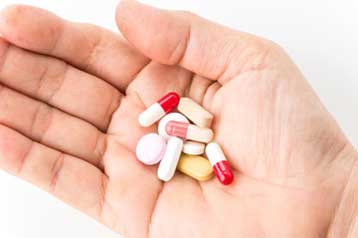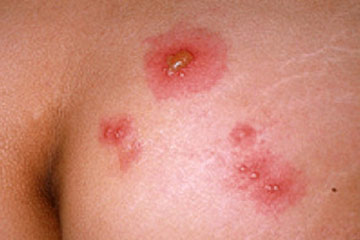Medical use of marijuana (Cannabis)
What is cannabis or marijuana?
Cannabis , also known as marijuana, is a plant from Central Asia that is grown in many parts of the world today. Marijuana (marihuana) is a colloquial name for dried leaves and flowers of drug cannabis varieties rich in THC (1-20% THC). The median content of THC of confiscated marijuana in the USA in 1997 was 4.2%. Marijuana available on prescription in the Netherlands contains up to 18% THC.
What are cannabinoids?
Cannabinoids are active chemicals in Cannabis that cause drug like effects throughout the body, including the central nervous system and the immune system. They are also known as phytocannabinoids. The main active cannabinoid in Cannabis is delta-9-THC. Another active cannabinoid is cannabidiol, which may relieve pain and lower inflammation without causing the "high" of delta-9-THC.
Cannabinoids may be useful in treating the side effects of cancer and cancer treatment.
Other possible effects of cannabinoids include:
- Anti-inflammatory activity.
- Blocking cell growth.
- Preventing the growth of blood vessels that supply tumors.
- Antiviral activity.
How is Cannabis administered?
Cannabis may be taken by mouth or may be inhaled. When taken by mouth (in baked products or as an herbal tea), the main psychoactive ingredient in Cannabis (delta-9-THC) is processed by the liver, making an additional psychoactive chemical (a substance that acts on the brain and changes mood or consciousness).
When Cannabis is smoked and inhaled, cannabinoids quickly enter the bloodstream. The additional psychoactive chemical is produced in smaller amounts than when taken by mouth.
A growing number of clinical trials are studying a medicine made from a whole-plant extract ofCannabis that contains specific amounts of cannabinoids. This medicine is sprayed under the tongue.
Have any preclinical (laboratory or animal) studies been conducted using Cannabis or cannabinoids?
Preclinical studies of cannabinoids have investigated the following activities:
Antitumor activity
- Studies in mice and rats have shown that cannabinoids may inhibit tumor growth by causing cell death, blocking cell growth, and blocking the development of blood vessels needed by tumors to grow. Laboratory and animal studies have shown that cannabinoids may be able to kill cancer cells while protecting normal cells.
- A study in mice showed that cannabinoids may protect against inflammation of the colon and may have potential in reducing the risk of colon cancer, and possibly in its treatment.
- A laboratory study of delta-9-THC in hepatocellular carcinoma (liver cancer) cells showed that it damaged or killed the cancer cells. The same study of delta-9-THC in mouse models of liver cancer showed that it had antitumor effects. Delta-9-THC has been shown to cause these effects by acting on molecules that may also be found in non-small cell lung cancercells and breast cancer cells.
- A laboratory study of cannabidiol in estrogen receptor positive and estrogen receptor negative breast cancer cells showed that it caused cancer cell death while having little effect on normal breast cells.
- A laboratory study of cannabidiol in human glioma cells showed that when given along with chemotherapy, cannabidiol may make chemotherapy more effective and increase cancer cell death without harming normal cells.
Stimulating appetite
- Many animal studies have shown that delta-9-THC and other cannabinoids stimulate appetite and can increase food intake.
Pain relief
- Cannabinoid receptors (molecules that bind cannabinoids) have been studied in the brain,spinal cord, and nerve endings throughout the body to understand their roles in pain relief.
- Cannabinoids have been studied for anti-inflammatory effects that may play a role in pain relief.
Have any clinical trials (research studies with people) of Cannabis or cannabinoid use by cancer patients been conducted?
No clinical trials of Cannabis as a treatment for cancer in humans have been found in the CAM on PubMed database maintained by the National Institutes of Health.
Cannabis and cannabinoids have been studied in clinical trials for ways to manage side effects of cancer and cancer therapies, including the following:
Nausea and vomiting
- Delta-9-THC taken by mouth: Two cannabinoid drugs approved in the United States are available under the names dronabinol and nabilone. Both dronabinol and nabilone are approved by the Food and Drug Administration (FDA) for the treatment of chemotherapy-related nausea and vomiting in patients who have not responded to standard therapy. Many clinical trials have shown that both dronabinol and nabilone worked as well as or better than some of the weaker FDA-approved drugs to relieve nausea and vomiting. Newer drugs given for chemotherapy-related nausea have not been directly compared with Cannabis or cannabinoids in cancer patients.
- Inhaled Cannabis: Three small trials have studied inhaled Cannabis for the treatment of chemotherapy-related nausea and vomiting. Various study methods and chemotherapy agents were used with mixed results. There is not enough information to interpret these findings.
go to top
Stimulating appetite:
- Delta-9-THC taken by mouth: A clinical trial compared delta-9-THC (dronabinol) and a standard drug (megestrol) in patients with advanced cancer and loss of appetite. Results showed that delta-9-THC was not as effective in increasing appetite or weight gain in advanced cancer patients compared with standard therapy. However, a clinical trial of patients with HIV/AIDS and weight loss found that those who took delta-9-THC had increased appetite and stopped losing weight compared with patients who took a placebo.
- Inhaled Cannabis: There are no published studies of the effect of inhaled Cannabis on cancer patients with loss of appetite. Studies of healthy people who inhaled Cannabisshowed that they consumed more calories, especially high-fat and sweet snacks.
Pain relief
- Combining cannabinoids with opioids: In a small study of 21 patients with chronic pain, vaporized Cannabis was added to slow-release oxycodone or morphine and given for five days. Results showed that combining vaporized Cannabis with morphine relieved pain better than morphine alone, while combining vaporized Cannabis with oxycodone did not produce significantly greater pain relief. These findings should be tested in further studies.
- Delta-9-THC taken by mouth: Two small clinical trials of oral delta-9-THC showed that it relieved cancer pain. In the first study, patients had good pain relief as well as relief of nausea and vomiting and better appetite. A second study showed that delta-9-THC could be given in doses that gave pain relief comparable to codeine. Higher doses of delta-9-THC were found to be more sedating than codeine. An observational study of nabilone also showed that it relieved cancer pain along with nausea, anxiety, and distress when compared with no treatment. Neither dronabinol nor nabilone is approved by the FDA for pain management.
- Whole Cannabis plant extract medicine: A study of a whole-plant extract of Cannabis that contained specific amounts of cannabinoids, which was sprayed under the tongue, found it was effective in patients with advanced cancer whose pain was not relieved by strong opioids alone. This treatment was studied using different doses in a randomized, placebo-controlled clinical trial of cancer patients with chronic pain not controlled by opioids. Patients who received the lower doses of cannabinoid spray showed markedly better pain control and less sleep loss compared with patients who received a placebo. Adverse side effects depended on the dose received. Only patients in the high-dose group had adverse side effects that made the treatment less beneficial than the placebo. Some patients using the cannabinoid spray were followed in a long-term study. Results showed that, for some patients, control of their cancer-related pain continued without needing higher doses of spray or higher doses of their other pain medicines.
- Inhaled Cannabis: Various clinical trials have shown benefits of inhaled Cannabis compared with placebo in relieving neuropathic pain. These include a study of inhaled Cannabis in patients with HIV -related peripheral neuropathy. Results found better pain control in theCannabis group than in the placebo group. Another study involved patients with various kinds of chronic pain that was not relieved by other pain medicines. Results showed that those treated with either low-dose or medium-dose inhaled Cannabis had improved pain relief at both doses compared to patients treated with a placebo. Side effects of the inhaledCannabis were minor. To date, no clinical trials have studied cannabinoids in the treatment of chemotherapy-related neuropathy in patients with cancer.
Anxiety and sleep
- Inhaled Cannabis: A small case series found that patients who inhaled marijuana had improved mood, improved sense of well-being, and less anxiety.
- Whole Cannabis plant extract spray: A trial of a whole-plant extract of Cannabis that contained specific amounts of cannabinoids, which was sprayed under the tongue, found that patients had improved sleep quality.
Have any side effects been reported from Cannabis and cannabinoids?
Adverse side effects of cannabinoids may include:
- Rapid beating of the heart.
- Low blood pressure.
- Muscle relaxation.
- Bloodshot eyes.
- Slowed digestion and movement of food by the stomach and intestines.
- Dizziness.
- Depression.
- Hallucinations.
- Paranoia.
Because Cannabis smoke contains many of the same substances as tobacco smoke, there are concerns about how smoked cannabis affects the lungs. A study of over 5,000 men and women without cancer over a period of 20 years found that smoking tobacco was linked with some loss of lung function but that occasional and low use of cannabis was not linked with loss of lung function.
Because use of Cannabis over a long time may have harmful effects on the endocrine and reproductive systems, rates of testicular germ cell tumors (TGCTs) in Cannabis users have been studied. Larger studies that follow patients over time and laboratory studies of cannabinoid receptors in TGCTs are needed to find if there is a link between Cannabis use and a higher risk of TGCTs.
Both Cannabis and cannabinoids may be addictive.
Symptoms of withdrawal from cannabinoids may include:
- Irritability.
- Trouble sleeping.
- Restlessness.
- Hot flashes.
- Nausea and cramping (rarely occur).
These symptoms are mild compared to withdrawal from opiates and usually lessen after a few days.
Are Cannabis or cannabinoids approved by the U.S. Food and Drug Administration for use as a cancer treatment in the United States?
The U.S. Food and Drug Administration has not approved Cannabis or cannabinoids for use as a cancer treatment.
Are Cannabis or cannabinoids approved by the U.S. Food and Drug Administration for use as a treatment for cancer-related symptoms or side effects of cancer therapy?
Cannabis is not approved by the U.S. Food and Drug Administration (FDA) for the treatment of any cancer-related symptom or side effect of cancer therapy.
Two cannabinoids (dronabinol and nabilone) are approved by the FDA for the treatment of chemotherapy-related nausea and vomiting in patients who have not responded to standard therapy.
go to top
Source
-
Questions and Answers About Cannabis
National Cancer Institute -
Marijuana
International Association for Cannabinoid Medicines (IACM)






